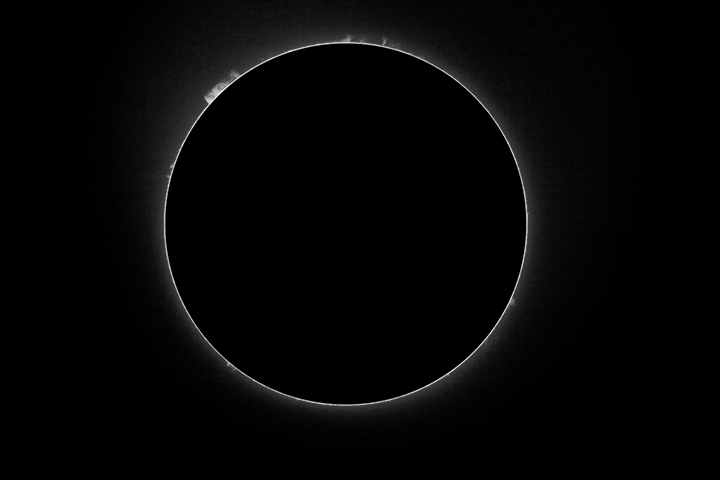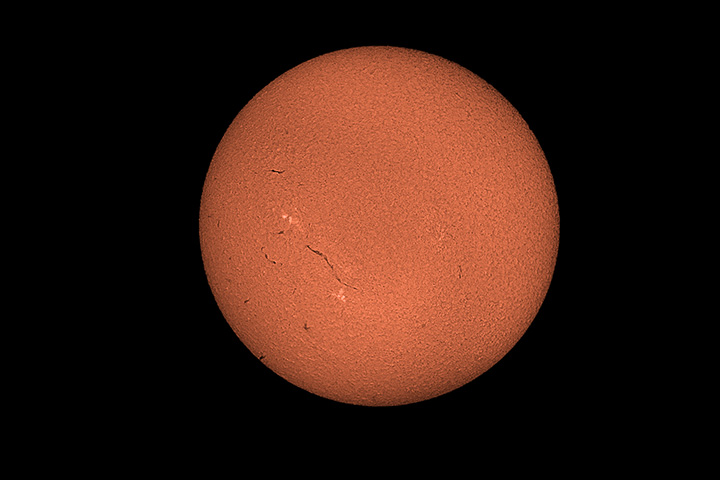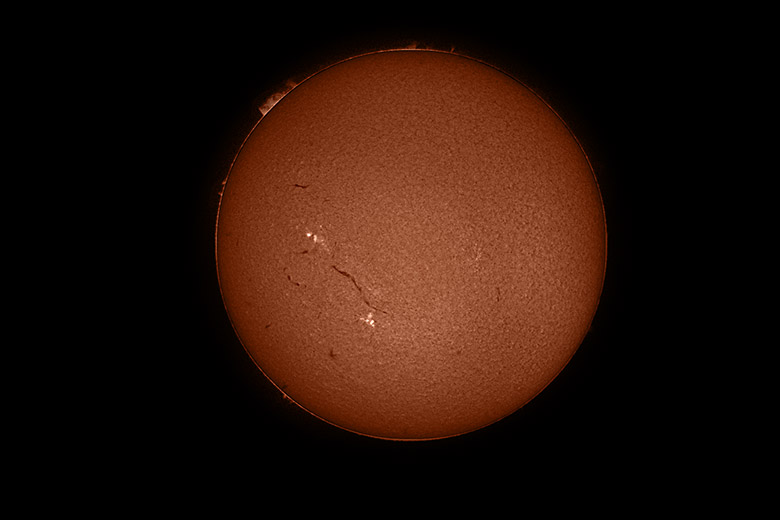| |

Canon 50D (unmodified). Lunt LS60THa. Single
etalon, 1/2s, ISO 400.
Click the image for wallpaper-sized view.
6/19/2010. Lessons
of the day:
- Focus like there's no tomorrow. Put a black
bag over your head. Wear reading glasses. Zoom all the way in
with Liveview. Use that vernier focusing knob. A lot.
- Since you're using LiveView to focus anyway,
go ahead and trip the shutter in that mode (d'oh! no mirror slap).
I was reading about the Samsung NX10 thinking it might be just
the thing for low-vibration astrophotography when I remembered...
shoot while in Liveview and you have the same advantage. I am
just astonishingly slow sometimes.
- One lesson from the deep sky seems directly applicable:
When in doubt, add photons. Stop stretching the data -- pour
on the light. There's plenty. The frame up top has 20x the exposure
of previous limb shots.
- Convert to B/W mode when opening the RAW image
(using Maxim to strip out the red channel is productive, too,
maybe even better, so experiment more with that, see below).
- Remove the counterweight shaft extension and
then use the 10-lb weight way up close to the mount. The Mach1
balances pretty well this way. One of those cute little five
pounders would be even better, but not better enough to buy.
- Look, I know that that ruby-red hydrogen-alpha
color is gorgeous, but people can't see very well at that wavelength.
If people can't see it, then maybe it would be a good idea to
refrain from displaying images of disk detail in real color.
Can I have another
"D'oh!"? That's why the experts mimic the lighter,
more readily visible orange hues of white-light solar images.
Thus:

Canon 50D (unmodified).
Lunt LS60T Ha. Double-stacked. 1/8s, ISO 400.
Click the image for wallpaper-sized view.

Same image, red
Bayer plane extracted in Maxim DL5, limb and disk detail
processed seperately in PhotoShop CS4. Click the photo for wallpaper-sized
image.
Late in the afternoon, I tried a TeleVue 20mm Plossl
in the B600 and found a much brighter (and smaller) Sun waiting
in there. Maybe this is the eyepiece to adopt for a quick look.
The 7mm Nagler shows much more detail, but owing to the dimness
of the comparatively large image, it requires much more concentration.
A robust subset of all available structure is visible at a glance
in the 20mm. When using the 20mm, I see why people prefer the 12mm
blocking filter. With a driven telescope, it doesn't feel claustrophobic
because the difference between black sky behind the Sun and black
sky behind the field stop / small blocking filter is not visible.
Nonetheless, the field around the small, bright, detailed solar
image is small. If you don't aim well, or if you let an undriven
telescope drift for more than a few seconds, the Sun bumps into
the black edge of the field (image diameter 4.8mm) will begin to
slide behind the edge of the field of view (field stop / filter
diameter 6mm) in less than 20 seconds.
Late tip found in a Lunt forum post by Eric Roel
who does lovely solar work from his observatory in Mexico: histogram
equalization is part of image preparation. A quick trial shows
this to be a promising, timesaving step.
|
2-inch refractor on an Astro-Physics Mach1GTO equatorial.
Today I discovered that the first law of
deepsky astrophotography — when in doubt, increase
exosure — applies to solar photography as well.
Here's a reminder that I endorse the second law, too: you
can never have too much mount.
|
Nostalgia warning! So,
who remembers "The Mr. Bill Show" out of Asheville, NC,
on WLOS-TV 13 that used to run every morning, rain or shine, hell
or high water, in the middle and late 60's? Mr. Bill (Norwood)
was the meteorologist for WLOS-TV (I learned this while Googling
him) who had 2-1/2 hours to fill every weekday morning. He ran
cartoons, Three Stooges shorts, kids' news (school closings, simplified
news stories), just about anything, including what I remember best:
science segments comprised of killer footage from this or that
project. I vividly remember film clips from the Lyot coronagraph
in Boulder, CO (?), showing time lapse images of solar prominences
in hydrogen-alpha light. Maybe he ran that film only two or three
times in his entire career (or, hell, maybe I remember them from
the old "Discover" show that also ran before school in
that era), but I so remember those clips. And I remember going
to K-Mart's photo counter to inquire about a hydrogen-alpha filter
so I could see such things for myself. I figured, hey, it would
cost $50, and I would have to save up for one, but it would be
worth it. It took 40+ years, and a more substantial cash outlay,
but really, this is my flying car. What's become of Bill
Norwood?
| |